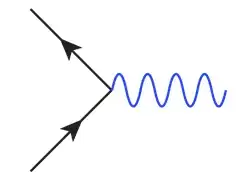Peskin in his QFT page 334 argued that $Z_1=Z_2$ to all orders in QED perturbation theory, but I couldn't understand his argument:
... With a generalization of the argument given there (section 7.4 for Ward identity), on can show that the diagrammatic identity (7.68) holds for digrams that include counterterm vertices in loops.
Let's assume this is granted true, but I got lost in his following argument:
Thus, if the counterterms $\delta_1$ and $\delta_2$ are determined up to order $\alpha^n$, the unrenormalized vertex diagram at $q^2=0$ equals the derivative of the unrenormalized self-energy diagram on-shell in order $\alpha^{n+1}$. To satisfy the renormalization conditions (10.40), we must then set the counterterms $\delta_1$ and $\delta_2$ equal to order $\alpha^{n+1}$. This recursive argument gives yet another proof that $Z_1=Z_2$ to all orders in QED perturbation theory.
What does he mean by unrenormalized vertex diagram?
Can somebody please explain the connections in his logic?
Thanks!



